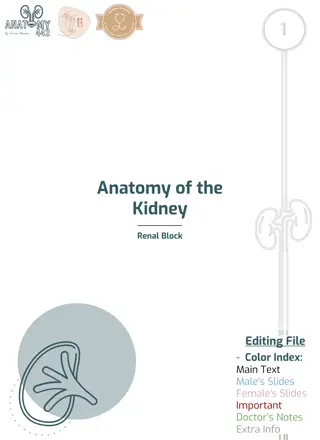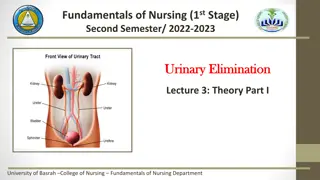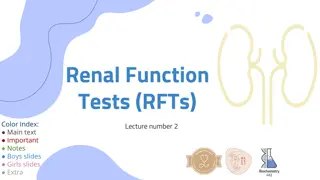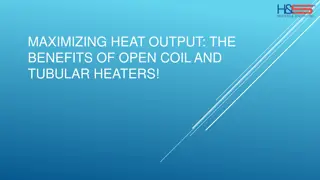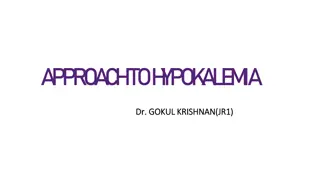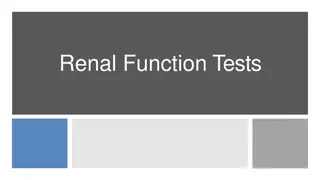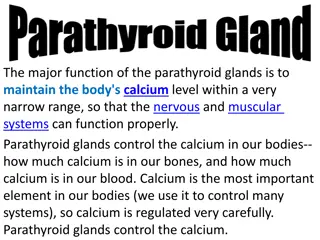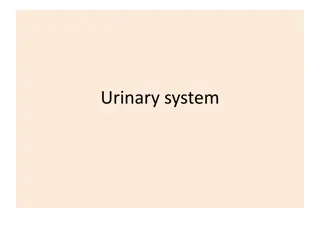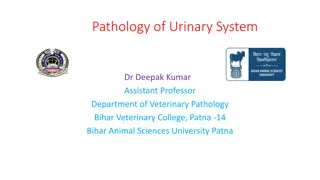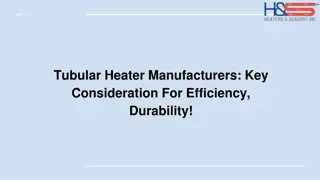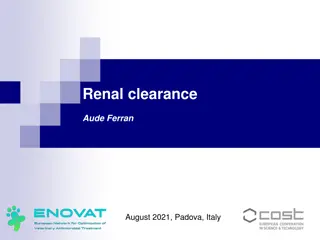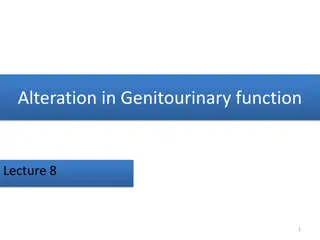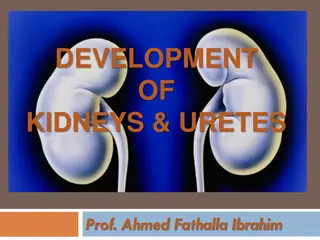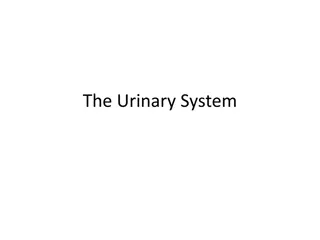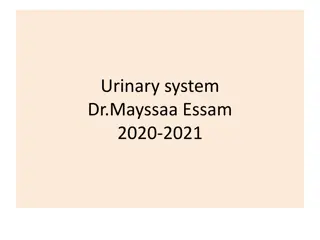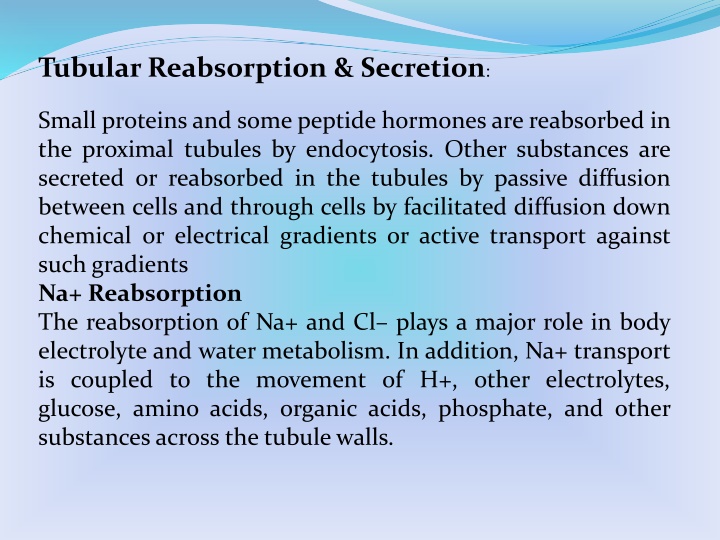
Tubular Reabsorption in Kidneys
Small proteins, peptide hormones, glucose, amino acids, and other substances are reabsorbed or secreted in the kidney tubules through different transport mechanisms. Na+ reabsorption, glucose reabsorption, and tubuloglomerular feedback are essential processes in maintaining electrolyte and water balance. Explore the intricate mechanisms of these processes and their role in renal function.
Download Presentation

Please find below an Image/Link to download the presentation.
The content on the website is provided AS IS for your information and personal use only. It may not be sold, licensed, or shared on other websites without obtaining consent from the author. If you encounter any issues during the download, it is possible that the publisher has removed the file from their server.
You are allowed to download the files provided on this website for personal or commercial use, subject to the condition that they are used lawfully. All files are the property of their respective owners.
The content on the website is provided AS IS for your information and personal use only. It may not be sold, licensed, or shared on other websites without obtaining consent from the author.
E N D
Presentation Transcript
Tubular Reabsorption & Secretion: Small proteins and some peptide hormones are reabsorbed in the proximal tubules by endocytosis. Other substances are secreted or reabsorbed in the tubules by passive diffusion between cells and through cells by facilitated diffusion down chemical or electrical gradients or active transport against such gradients Na+ Reabsorption The reabsorption of Na+ and Cl plays a major role in body electrolyte and water metabolism. In addition, Na+ transport is coupled to the movement of H+, other electrolytes, glucose, amino acids, organic acids, phosphate, and other substances across the tubule walls.
The tubular cells are connected by tight junctions at their luminal edges, but there is space between the cells along the rest of their lateral borders. Much of the Na+ is actively transported into these extensions of the interstitial space, the lateral intercellular spaces Normally about 60% of the filtered Na+ is reabsorbed in the proximal tubule, primarily by the Na+ H+ exchange. Another 30% is absorbed via the Na+ 2Cl K+ cotransporter in the thick ascending limb of the loop of Henle, and about 7% is absorbed by Na+ Cl cotransport in the distal convoluted tubule. The remainder of the filtered Na+, about 3%, is absorbed via the ENaC(epithelial sodium channels) in the collecting ducts, and this is the portion that is regulated by aldosterone and angiotensin II for homeostatic adjustments in Na+ balance.
Glucose Reabsorption Glucose, amino acids, and bicarbonate are reabsorbed along with Na+ in the early portion of the proximal Tubule Farther along the tubule, Na+ is reabsorbed with Cl . Glucose is typical of substances removed from the urine by secondary active transport. Essentially all of the glucose is reabsorbed, and no more than a few milligrams appear in the urine per 24 hours. GlucoseTransport Mechanism Glucose reabsorption in the kidneys is similar to glucose reabsorption in the intestine Glucose and Na+ bind to the common carrier in the luminal membrane, and glucose is carried into the cell as Na+ moves down its electrical and chemical gradient. The Na+ is then pumped out of the cell into the interstitium, and the glucose is transported into the interstitial fluid.
Tubuloglomerular Feedback & Glomerulotubular Balance Signals from the renal tubule in each nephron feed back to affect filtration in its glomerulus. As the rate of flow through the ascending limb of the loop of Henle and first part of the distal tubule increases, glomerular filtration in the same nephron decreases, and, conversely, a decrease in flow increases the GFR . This process, which is called tubuloglomerular feedback, constancy of the load delivered to the distal tubule. The sensor for this response is the macula densa . The amount of fluid entering the distal tubule at the end of the thick ascending limb of the loop of Henle depends on the amount of Na+ and Cl in it. tends to maintain the
. The Na+ and Cl enter the macula densa cells via the Na+ K+ 2Cl cotransporter in their apical membranes.The increased Na+ causes increased Na+ K+ ATPase activity and the resultant increased ATP hydrolysis causes more adenosine to be formed. Presumably, adenosine is secreted from the basal membrane of the cells and acts via adenosine A1 receptors on the macula densa cells to increase their release of Ca2+ to the vascular smooth muscle in the afferent arterioles. This causes afferent vasoconstriction and a resultant decrease in GFR. Presumably, a similar mechanism generates a signal that decreases renin-secretion by the adjacent juxtaglomerular cells in the afferent arteriole
Conversely, an increase in GFR causes an increase in the reabsorption of solutes, and consequently of water, primarily in the proximal tubule, so that in general the percentage of the solute reabsorbed is held constant. This process is called glomerulotubular balance, and it is particularly prominent for Na+. The change in Na+reabsorption occurs within seconds after a change in filtration,
Waterexcretion: Proximal Tubule Many substances are actively transported out of the fluid in the proximal tubule, but fluid obtained by micropuncture remains essentially isosmotic to the end of the proximal tubule Therefore, in the proximal tubule, water moves passively out of the tubule along the osmotic gradients set up by active transport of solutes, and isotonicity is maintained. Loopof Henle The descending limb of the loop of Henle is permeable to water, but the ascending limb is impermeable
Distal Tubule The distal tubule, particularly its first part, is in effect an extension of the thick segment of the ascending limb. It is relatively impermeable to water, and continued removal of the solute in excess of solvent further dilutes the tubular fluid. About 5% of the filtered water is removed in this segment. Collecting Ducts The collecting ducts have two portions: a cortical portion and a medullary portion. The changes in osmolality and volume in the collecting ducts depend on the amount of vasopressin acting on the ducts. This antidiuretic hormone from the posterior pituitary gland increases the permeability of the collecting ducts to water.
Water intake and excretion: The average daily fluid intake is about 2.5 L. The amount needed to replace losses from the urine and other sources is about 1 to 1.5 L/day in healthy adults. However, on a short-term basis, an average young adult with normal kidney function may ingest as little as 200 mL of water each day to excrete the nitrogenous and other wastes metabolism. More is needed in people with any loss of renal concentrating capacity. Renal concentrating capacity is lost in The elderly People with diabetes insipidus, certain renal disorders, hypercalcemia, chronic overhydration, People who ingest ethanol. People with osmotic diuresis (eg, due to high-protein diets or hyperglycemia) generated by cellular
Other obligatory water losses are mostly insensible losses from the lungs and skin, averaging about 0.4 to 0.5 mL/kg/h or about 650 to 850 mL/day in a 70-kg adult. With fever, another 50 to 75 mL/day may be lost for each degree C of temperature elevation above normal. GI losses are usually insignificant except when marked vomiting, diarrhea, or both occur. Sweat losses can be significant during environmental heat exposure or excessive exercise. Water intake is regulated by thirst. Thirst is triggered by receptors in the anterolateral hypothalamus that respond to increased serum osmolality (as little as 2%) or decreased body fluid volume. Rarely hypothalamic dysfunction decreases the capacity for thirst.
Water excretion by the kidneys is regulated primarily by ADH (vasopressin). ADH is released by the posterior pituitary and results in increased water reabsorption in the distal nephron. ADH release is stimulated by any of the following: Increased serum osmolality Decreased blood volume Decreased BP Stress ADH release may be impaired by certain substances (eg, ethanol, and central diabetes insipidus . Water intake decreases serum osmolality. Low serum osmolality inhibits ADH secretion, allowing the kidneys to produce dilute urine. The diluting capacity of healthy kidneys in young adults .
Counter Current Mechanism: How Concentrated Urine Is Produced Kidneys have Mechanisms for excreting excess water. Mechanisms for excreting excess solutes. Nephron types: There are two types of nephron: Superficial (cortical) nephron: [85 %] Capable of forming dilute urine Juxtamedullary [15 %] Capable of forming concentrated (> 300 mOsm/kg) urine
Descending Loop Ascending Loop highly permeable to water impermeable to water impermeable to Na+ permeable to Na+ (mediated by Na+/K+/2Cl What is Counter current mechanism? Counter current mechanism is the process by which renal medullary interstitial fluid becomes hyper-osmotic. Components of Counter Current Mechanism: Counter current multiplier (Loop of Henle acts here) Counter current exchanger (vasa recta acts here)
Loop of Henleand vasa recta (blood supplier to the juxtamedullary nephron) run parallellyand in counter direction, such arrangement is the basis of this mechanism.
Descending limb is not permeable to electrolytes. So it is of no importance in establishing hyper osmolarity in medullary interstitium. Thin transports electrolytes (mainly Na+ and Cl-) to the medullary interstitium by the process of simple diffusion and 1 Na+1K+-2Cl- co transporter system respectively. This process occurs repeatedly and more and more solutes (not water) are trapped in medullary interstitium hyperosmotic renal medullary interstitium (1200- 1400 mosm/L) and thick segments of ascending limb which results in
Counter current exchanger: Vasa recta maintain hyperosmolarityof medullary interstitiumas counter current exchanger. Vasa recta forms a U shaped bend parallel to loop of Henle. Osmolarity in renal medulla is graded (Osmolarity increases in downward direction as descending limb of U gradually passes through hyperosmotic medulla, solute enter into it from medulla. But ascending limb passes progressively through decreased osmolarity of medulla (as osmolarity lowers in upward direction). Hence solutes return back to renal medulla (which entered in descending limb of earlier) So counter current exchanger functions by- Tendency of electrolytes to be recirculated Tendency of water to be removed by vasa recta

